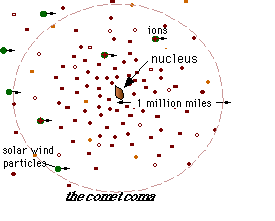This image of the nucleus of Halley's comet comes from the Giotto spacecraft.
Click on image for full size
JPL
Measurements from Halley's comet
Among the things we learned from a suite of spacecraft which visited Halley's comet in 1986 are:
- what a comet nucleus looks like up close (no one had ever seen the nucleus before.)
- that the nucleus had craters and other surface features
- that evaporation occured only from specific jets, or cracks in the surface
- that gases of the coma include H+, C+, OH+, CO+, CN+, N2+, H2O+, CO+, and H3O+, among others. (These measurements help scientists determine more accurately what the nucleus is made of, as well as verifing what ground-based measurements of molecular spectra had suggested was present.)
- how big the coma is, compared to the actual nucleus (100,000 miles vs. 15 miles)
- that instead of being bright like a surface made of ice, the nucleus was "dark", which suggests there may be a significant amount of organic material such as formaldehyde (an organic molecule) on the surface.
- how the magnetic field of the Sun responded to the presence of the comet coma
|
You might also be interested in:

Six spacecraft flew by Halley's comet in 1986. There were two spacecraft launched from Japan, Suisei and Sakigake, and two from the Soviet Union, Vega 1 & 2. One spacecraft, ICE, from the United States
...more
As the ices of the comet nucleus evaporate, they expand rapidly into a large cloud around the central part of the comet. This cloud, called the coma, is the atmosphere of the comet and can extend for millions
...more
Hale-Bopp continues to offer surprises as astronomers study the comet. Using the Hubble Space Telescope and the International Ultraviolet Explorer, astronomers have found that there are distinctly different
...more
Comets are observed to go around the sun in a long period of time or a short period of time. Thus they are named "long-period" or "short-period" comets. One group of short-period comets, called the Jupiter
...more
Scientists have learned a great deal from the crash of comet Shoemaker-Levy 9. Scientists traced the orbit of the comet backwards in time to guess its origin. This calculation, along with the discovery
...more
Mathematical theory suggests that comet Shoemaker-Levy 9 was likely a short-period comet which was captured into orbit around Jupiter in 1929 and began to execute the trajectory plotted in this diagram.
...more
When evaporation begins, the gas is propelled from the nucleus at supersonic speed (depicted by arrows in the figure). Because of the low gravity in space, this means that the molecules from the nucleus
...more















